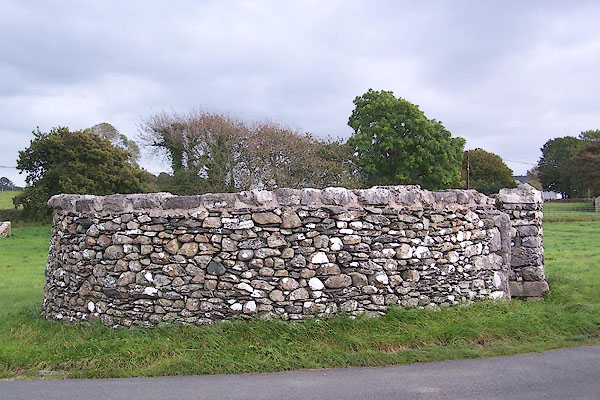





BOF02.jpg
Mills, Nigel: 2015: Pounds and Pinfolds of Cumbria::: includes fascinating historical information
PINFOLDS.htm
 Lakes Guides, topics
Lakes Guides, topics |
 |
   |
||
| pinfolds, Cumbria | ||||
| county:- | Cumbria | |||
| Pinfolds and Pounds |
||||
| A secure place for holding stray sheep, pigs and cattle, found widely in villages
from mediaeval times. The pinfold or pound can be anywhere. It might be a walled or
hedged enclosure, or just a field where beasts can be tethered. |
||||
 BOF02.jpg |
||||
| The word pound derives from AngloSaxon pund, enclosure. Pinfold, via pundfald, from
pund and fald, enclosure. |
||||
|
|
||||
| In Damage Feasant and the law of taking distress |
||||
| So far I have found little descriptive evidence about pinfolds except Mr Dobbie's
to whom I owe gratitude. |
||||
| Pinfolds remain as a reminder of laws of England which have their origins before the
Norman Conquest, almost before England was England. Sir Henry Maine, 1875:- |
||||
| "There is no more ancient institution in our history than the village pound: it is
far older than the King's Bench, and probably older than the Kingdom." |
||||
| The man in charge of the pinfold or pound was a pounder or pinder, usually paid by
the manor court or perhaps by the neighbours. |
||||
| A landowner could impound trespassing beasts, in damage feasant, for:- |
||||
| "... doing injury by breaking hedges, feeding, or even trampling the ground." |
||||
| This is an example of the practice of Taking Distress, distraining upon another man's
property to recompense a debt. It is not done without recourse to a court of law.
You can impound the beasts, but must do this in the appointed pound ie pinfold, and
submit to the ruling of the relevant court, perhaps a local manor court. Halsbury
1971 describes some early statutes. |
||||
| The Statute of Marlborough 1265, states that: |
||||
| " No one can take distress on his own account but must defer to the king's court: he
may seize and impound property but must submit to legal judgement. " |
||||
| Halsbury again, referring to the Statutes of the Exchequer, a little later in history,
says that: |
||||
| "The owner of impounded beasts may feed them; beasts may not be sold within 15 days;
beasts that work the land may not be taken; the value of distress taken must be reasonable
as judged by neighbours not strangers. The law acknowledging commonsense." |
||||
| Further clarification is given in the Distress Act 1554. |
||||
| Damage Feasant was abolished by the Animals Act 1971. The only remaining function
of a pinfold seems to be in taking distress for rent owed, or for impounding an animal
removed from a public highway (not over common land) under the Highways Act 1959. |
||||
| Some pinfolds are still apparent on the ground, others have left traces, many are
gone through neglect, by road building and other development, without a by-your-leave.. |
||||
| But: it is still an offence to damage a pinfold; the fine might be £20.00; so I am
told. |
||||
|
|
||||
| Two questions arose in my mind when considering pinfolds in Cumbria. |
||||
| How did the Border Law interrelate to laws dealing with Taking Distress, and thus
pinfolds? |
||||
| How do the arrangements made by shepherds meetings, as described in Shepherds Guides
from the early 19th century, relates to the same laws? |
||||
|
|
||||
| The County series maps issued by the Ordnance Survey at 6 and 25 inches to the mile
have been the main source for including pinfolds in the Old Cumbria Gazetteer. We
have made a careful search on the 6 inch sheets of the areas which now make Cumbria.
A search on the 25 inch sheets in built up areas would probably locate a few more;
a job for the future. We have found pinfolds that are on neither 6 nor 25 inch maps. |
||||
| A few more pinfolds have been added from the list made by Nigel Mills, 2015. |
||||
|
|
||||
| references:- |
Dobbie, B M Willmott: 1979: Pounds or Pinfolds, and Lockups: Bath University Library
(Bath, Somerset) Mills, Nigel: 2015: Pounds and Pinfolds of Cumbria::: includes fascinating historical information PINFOLDS.htm |
|||
|
|
||||
 Lakes Guides menu.
Lakes Guides menu.